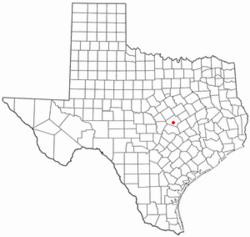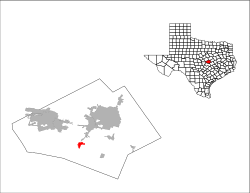Buttermilk Creek complex facts for kids
Quick facts for kids
Buttermilk Creek complex
|
|
|---|---|

Location of Salado, Texas
|
|
 |
|
| Country | United States |
| State | Texas |
| County | Bell |
| Elevation | 600 ft (183 m) |
| Time zone | UTC-6 (Central (CST)) |
| • Summer (DST) | UTC-5 (CDT) |
| ZIP code |
76571
|
The Buttermilk Creek complex is an ancient human settlement found near Buttermilk Creek in Salado, Texas. This site is about 15,500 years old. If this age is correct, it means people lived in the Americas much earlier than previously thought, even before the well-known Clovis culture.
Contents
Discovering Ancient Texans
The Buttermilk Creek complex was found at the Debra L. Friedkin Paleo-Indian archaeological site in Bell County, Texas. This discovery shows that humans were in the Americas before the Clovis people. For a long time, many thought the Clovis people were the first to explore and settle North America.
Scientists have many reasons to believe this site is older than Clovis. They used a method called optically stimulated luminescence (OSL) dating. This method looks at light energy trapped in soil to find out when it was last exposed to sunlight. The dates from the site range from 13,200 to 15,500 years ago. Also, the layers of soil were not disturbed, and many stone tools were found.
Why This Area Was Important
Michael R. Waters from Texas A&M University and his team started digging at the Debra L. Friedkin Site in 2006. The site is near the Gault site, another ancient place found in 1998.
Early humans liked the Buttermilk Creek area for many reasons. The climate was good, there was plenty of food, and water was available all year. Most importantly, the area had high-quality Edward's Chert stone. This stone was perfect for making tools.
How Ancient Tools Were Made
People made tools from chert using a skill called flint knapping. They would strike larger stones or antler billets against chert pieces. This removed flakes until the stone became a sharp, two-sided tool.
Then, they used smaller antlers to shape these tools even more. They made spear points, knives, and other useful items. They also created single-sided tools like blades by carefully shaping a stone and striking it with an antler.
The "Clovis First" Idea
For many years, archaeologists believed the first people in the New World were the Clovis people. They thought the Clovis people came from Siberia, crossed a land bridge called Beringia, and arrived in the Americas between 13,200 and 12,800 years ago. It was believed that Clovis people, with their special spear points, quickly spread across North and South America.
This idea was called the "Clovis First" model. But recently, this idea has been questioned. The discovery of the Monte Verde site in Chile changed things. This site has dates going back 14,600 years ago, making it older than Clovis. It was the first site widely accepted as "pre-Clovis."
New Discoveries Challenge Old Ideas
The acceptance of Monte Verde opened the door for other older sites to be considered. Before the Buttermilk Creek complex was found, there wasn't strong proof of pre-Clovis cultures in North America.
Several other sites in the U.S. might also be pre-Clovis, including:
- Meadowcroft Rock Shelter (Pennsylvania)
- Topper (South Carolina)
- Page-Ladson (Florida)
- Cactus Hill (Virginia)
- The Schaefer and Hebior mammoth sites in Kenosha County, Wisconsin
- Lovewell (Kansas), at Lovewell Reservoir
- La Sena (Nebraska)
- Paisley Caves (Oregon)
Even though these sites show signs of being older than Clovis, some of their findings are still debated. The Buttermilk Creek complex, however, has very clear evidence. This discovery helps archaeologists learn more about the first humans in the New World. They want to know when and how these early people arrived and where they came from.
Digging Up the Past
Archaeologists dug at two main areas at the Debra L. Friedkin site: Block A and Block B. These areas are old floodplains from the Ice Age.
The oldest human remains, from the pre-Clovis time, were found in Block A. This area is made up of 52 squares, each 1 meter by 1 meter. Block A was buried under soil from a nearby hill and 1.4 meters of clay. This clay was slowly deposited by floods from Buttermilk Creek.
The Buttermilk Creek complex is found in a type of soil called vertisols. Scientists believe the layers of soil in Block A are undisturbed. This means artifacts haven't moved around much since they were buried. They know this because artifacts of different sizes are not sorted by depth. Also, a type of calcium carbonate is only on tools in the deepest layers. Most importantly, the OSL dates are in the correct order, from oldest at the bottom to newest at the top.
The Research Team
Many experts worked together to study the findings from Block A. This included OSL dating specialists, geologists, geophysicists, a soil scientist, and many archaeologists. This team approach helped them understand the site fully.
Layers of History
Block A has 9 different soil layers.
- The Folsom layer is about 2.5 cm thick and contains 3 Folsom spear points.
- Below Folsom is the Clovis layer, also 2.5 cm thick, with typical Clovis tools.
- The Buttermilk Creek complex is found below the Clovis layer. This layer is about 20 cm thick and contains many artifacts. OSL dates from this layer range from 14,000 to 17,500 years ago. Spear points with stems were found throughout this layer, dating from about 15,500 to 13,500 years ago. Triangular spear points were found from around 14,000 years ago.
The excavations show that people lived at this site almost continuously. They were there during the Buttermilk Creek complex time, and then during the Clovis, Folsom, Golondrina, Dalton, Early Archaic, Late Archaic, and Late Prehistoric periods.
Tools and Artifacts
The Buttermilk Creek complex has a very large and varied collection of stone tools. This is one of the main reasons why scientists believe this site is truly older than Clovis. Other possible pre-Clovis sites often don't have as much clear evidence.
The complex has yielded 15,528 pre-Clovis stone artifacts. These include large and small stone flakes, plus many tools.
What Tools Were Found?
Scientists carefully studied the tools. They found:
- 5 blades (long, thin flakes)
- 14 bladelets (small blades)
- 12 bifaces (tools shaped on both sides)
- 1 discoidal core (a round stone from which flakes were removed)
- 23 tools with modified edges
- 3 radial break tools
- 1 piece of polished hematite (a mineral)
Scientists also looked at some tools under a microscope to see how they were used. This is called use-wear analysis. Four tools showed signs of cutting, grooving, or carving hard materials like bone, wood, or antler.
Connecting the Cultures
The stone flakes found in the Folsom, Clovis, and Buttermilk Creek layers are similar. This suggests that people from all three periods used the site for similar purposes, mainly for the final stages of tool making.
However, the Buttermilk Creek people seemed to use the site for more different tasks than the Folsom and Clovis people.
Some flakes found in the Buttermilk Creek complex suggest that these early people were starting to develop the tool-making skills that would become common in later Clovis technology. Both Clovis and Buttermilk Creek layers also show examples of blades. This suggests that Clovis tool-making might have developed from the Buttermilk Creek complex.
But there are also differences. Unlike Folsom and Clovis tools, the Buttermilk Creek tools do not show signs of "fluting." Fluting is a special groove made on spear points by Clovis and Folsom people.
Scientists have also found some "refits" at the site. This means they found pieces of stone that fit back together, showing they came from the same original stone. This helps them understand how tools were made.
Oldest Weapons in North America
In 2016, Professor Michael Waters and his team found the oldest weapons ever discovered in North America at this site. These were ancient spear points, about 3-4 inches long. They are dated to 15,500 years ago. They were made of chert stone and found deep under the ground with other tools. Scientists believe these points were used to hunt animals in the area. These important findings were published in 2018.
How Scientists Date the Site
Because there were not many well-preserved organic materials (like wood or bone) at the site, scientists used optically stimulated luminescence (OSL) to date it. A total of 63 OSL dates were taken. These dates, along with the types of tools found in each layer, helped scientists figure out the age of each cultural period at the site.
To get OSL samples, scientists hammered copper pipes into the soil layers. Each sample was tested using three different OSL dating methods.
The OSL dates helped show that the site's layers and cultural periods are undisturbed and in the correct time order. This supports the idea that the Buttermilk Creek complex is indeed evidence of a human presence before the Clovis people.
Some experts have questioned the dating of the site. They point out that the soil type (vertisols) can shift when it gets wet and dry, which might disturb the layers. Also, they have concerns about the large error ranges in some OSL dates and how scientists estimated the water content of the soil over thousands of years.
See also
 In Spanish: Complejo de Buttermilk Creek para niños
In Spanish: Complejo de Buttermilk Creek para niños
- Archaeology of the Americas
- Models of migration to the New World
- Norte Chico civilization

